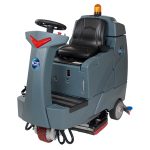 Nothing negatively affects productivity and puts your employees at risk of injury like an uncomfortable work environment. Standing for prolonged periods can cause injuries that are linked to billions of dollars in losses every year due to high absenteeism, reduced productivity, higher insurance rates and increased worker compensation. Our ergonomic anti-fatigue floor matting from M+A Matting can keep your employees more comfortable and avoid these issues.
Nothing negatively affects productivity and puts your employees at risk of injury like an uncomfortable work environment. Standing for prolonged periods can cause injuries that are linked to billions of dollars in losses every year due to high absenteeism, reduced productivity, higher insurance rates and increased worker compensation. Our ergonomic anti-fatigue floor matting from M+A Matting can keep your employees more comfortable and avoid these issues.
How does anti-fatigue matting work?
When employees have to stand for prolonged periods, blood flow is restricted, causing soreness in the lower extremities and overall fatigue. Our anti-fatigue floor mats support the muscles in the back and lower legs while promoting subtle movement in the calf and leg muscles. This contributes to an increase in the flow of oxygen and blood.
Picture yourself standing on a soft surface: it gives way as you apply pressure, and your lower body makes small muscle movements to compensate. This stimulates the increased blood and oxygen flow.
What is compression deflection?
You’ll hear this term a lot when we talk about anti-fatigue matting. It’s the measurement we use to understand the displacement of a mat under pressure and basically how hard or soft it feels under weight. For example, a 150-pound person applies a load of 20 pounds per square inch (psi). A load applied at 40 psi equates to about a 600-pound person. The optimum deflection for both loads, the amount the mat is displaced under pressure, should be between 20% and 60%. If it’s less, the mat will feel too hard. If it’s more, the mat will feel too soft. The sweet spot is in between those two percentages.
How does material affect performance?
A floor mat’s performance and durability is directly related to its material. Mats are made of one of the following three materials, or a blend.
PVC: The low-cost leader, PVC saves money but is less durable than polyurethane or rubber. It also doesn’t stand up to environmental changes as well. These mats have a bad reputation for cracking, rippling and curling at the edges, which can become a safety hazard. It’s also less slip-resistant than rubber, especially when wet.
If your budget demands choosing a PVC-based floor mat, we highly recommend opting for one whose surface is molded to a foam base instead of glued. This can help prolong damages and reduce the risk of curling or cracking.
Rubber: Nitrile rubber is a great choice for floor mats, particularly in industrial environments. It’s slip-resistance is incredible, and it won’t degrade from exposure to oil or grease. Nitrile rubber mats are also resistant to slag and other chemicals, making them safe to use around grinding and welding.
This Comfort Flow mat from M+A Matting is made of nitrile and is specially designed for wet areas where oil, grease and chemicals may be present. The drainage holes let liquid flow through, and anti-microbial treatment stops odors while preventing degradation. With excellent anti-fatigue qualities, chemical resistance and a lightweight design, this mat is ideal for foodservice locations.
Floor mats made from a combination of nitrile rubber and PVC offer the best of both worlds: they are oil and grease resistant and may be less expensive than pure nitrile mats.
This anti-fatigue mat from M+A Matting is made of a combination of nitrile and PVC closed cell foam. The 5/8”-thick mat is slip resistant, durable and beveled for safe egress. We highly recommend this mat for its superior anti-fatigue properties for employee comfort and ergonomic benefits.
Polyurethane: Mats made from polyurethane tend to be the most expensive but lack the qualities necessary to succeed in industrial environments. They are ideal when it comes to promoting comfort in commercial environments, and they can be used in dry environments or those with slight dampness or oil. This material is heat safe up to approximately 400 degrees so should not be used around slag.
Overall, these generalizations can help you choose the right anti-fatigue floor matting for your facility, but we do recommend considering the specifications of each particular mat to make direct comparisons. Our team is happy to help you make the right choice — contact us today to start the conversation!



